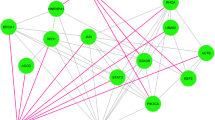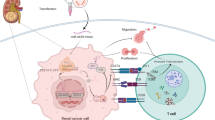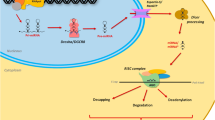Abstract
Glioblastoma (GBM) is the most lethal type of primary brain tumor and is characterized by diffuse infiltrative growth. However, the mechanisms that control this phenotype remain largely unknown. Emerging evidence has demonstrated that the abnormal expression of microRNAs and their target genes are involved in the migration and invasion of glioma cells. In this study, we demonstrated that microRNA-720 (miR-720) was significantly upregulated in glioma tissues and cells. Functional experiments showed that overexpression of miR-720 promotes glioma migration and invasion, while downregulation of miR-720 inhibits glioma migration and invasion. Meanwhile, we found that threonyl-tRNA synthetase like-2 (TARSL2) was a direct and functional target of miR-720 in glioma. Reintroduction of TARSL2 into glioma cells repressed the invasion promoting function of miR-720, whereas downregulation of TARSL2 reversed the anti-invasion function of anti-miR-720. Furthermore, quantitative real-time polymerase chain reaction results showed that miR-720 was inversely correlated with TARSL2 expression in 40 GBM tissues. Finally, in vivo experiments showed that miR-720 promotes glioma growth and upregulates invasion-related genes in nude mice. Overall, our findings suggest increasing miR-720 enhances glioma migration and invasion through downregulation of TARSL2, which may provide novel insight into the treatment of glioma.







Similar content being viewed by others
References
Wen PY, Kesari S. Malignant gliomas in adults. N Engl J Med. 2008;359(5):492–507. https://doi.org/10.1056/NEJMra0708126.
Onishi M, Ichikawa T, Kurozumi K, Date I. Angiogenesis and invasion in glioma. Brain Tumor Pathol. 2011;28(1):13–24. https://doi.org/10.1007/s10014-010-0007-z.
Rupaimoole R, Slack FJ. MicroRNA therapeutics: towards a new era for the management of cancer and other diseases. Nat Rev Drug Discovery. 2017;16(3):203–22. https://doi.org/10.1038/nrd.2016.246.
Yu W, Liang S, Zhang C. Aberrant miRNAs regulate the biological hallmarks of glioblastoma. NeuroMol Med. 2018;20(4):452–74. https://doi.org/10.1007/s12017-018-8507-9.
Li X, Kong S, Cao Y. miR-1254 inhibits progression of glioma in vivo and in vitro by targeting CSF-1. J Cell Mol Med. 2020;24(5):3128–38. https://doi.org/10.1111/jcmm.14981.
Zeng A, Yin J, Wang Z, Zhang C, Li R, Zhang Z, et al. miR-17-5p-CXCL14 axis related transcriptome profile and clinical outcome in diffuse gliomas. Oncoimmunology. 2018;7(12):e1510277. https://doi.org/10.1080/2162402x.2018.1510277.
Zhang R, Luo H, Wang S, Chen W, Chen Z, Wang HW, et al. MicroRNA-377 inhibited proliferation and invasion of human glioblastoma cells by directly targeting specificity protein 1. Neuro Oncol. 2014;16(11):1510–22. https://doi.org/10.1093/neuonc/nou111.
Kawachi H, Sugahara K, Nakamura Y, Katakura A, Minaguchi K, Shibahara T. Deletion polymorphism at chromosome 3q26.1 and oral squamous cell carcinoma. Int J Oncol. 2013;42(2):384–90. https://doi.org/10.3892/ijo.2012.1749.
Bhat NS, Colden M, Dar AA, Saini S, Arora P, Shahryari V, et al. MicroRNA-720 regulates E-cadherin-alphaE-catenin complex and promotes renal cell carcinoma. Mol Cancer Ther. 2017;16(12):2840–8. https://doi.org/10.1158/1535-7163.mct-17-0400.
Das SG, Romagnoli M, Mineva ND, Barille-Nion S, Jezequel P, Campone M, et al. miR-720 is a downstream target of an ADAM8-induced ERK signaling cascade that promotes the migratory and invasive phenotype of triple-negative breast cancer cells. Breast Cancer Res. 2016;18(1):40. https://doi.org/10.1186/s13058-016-0699-z.
Tang Y, Lin Y, Li C, Hu X, Liu Y, He M, et al. MicroRNA-720 promotes in vitro cell migration by targeting Rab35 expression in cervical cancer cells. Cell Biosci. 2015;5:56. https://doi.org/10.1186/s13578-015-0047-5.
Wang X, Kuang Y, Shen X, Zhou H, Chen Y, Han Y, et al. Evaluation of miR-720 prognostic significance in patients with colorectal cancer. Tumour Biol. 2015;36(2):719–27. https://doi.org/10.1007/s13277-014-2697-z.
Shinozuka E, Miyashita M, Mizuguchi Y, Akagi I, Kikuchi K, Makino H, et al. SnoN/SKIL modulates proliferation through control of hsa-miR-720 transcription in esophageal cancer cells. Biochem Biophys Res Commun. 2013;430(1):101–6. https://doi.org/10.1016/j.bbrc.2012.11.005.
Li LZ, Zhang CZ, Liu LL, Yi C, Lu SX, Zhou X, et al. miR-720 inhibits tumor invasion and migration in breast cancer by targeting TWIST1. Carcinogenesis. 2014;35(2):469–78. https://doi.org/10.1093/carcin/bgt330.
Chen P, Zhang G, Zhou Q, Li Z. Plasma microRNA-720 may predict prognosis and diagnosis in glioma patients. Biosci Rep. 2020;40:7. https://doi.org/10.1042/bsr20201449.
Nie A, Sun B, Fu Z, Yu D. Roles of aminoacyl-tRNA synthetases in immune regulation and immune diseases. Cell Death Dis. 2019;10(12):901. https://doi.org/10.1038/s41419-019-2145-5.
Kwon NH, Fox PL, Kim S. Aminoacyl-tRNA synthetases as therapeutic targets. Nat Rev Drug Discovery. 2019;18(8):629–50. https://doi.org/10.1038/s41573-019-0026-3.
Hyeon DY, Kim JH, Ahn TJ, Cho Y, Hwang D, Kim S. Evolution of the multi-tRNA synthetase complex and its role in cancer. J Biol Chem. 2019;294(14):5340–51. https://doi.org/10.1074/jbc.REV118.002958.
Kim K, Park SJ, Na S, Kim JS, Choi H, Kim YK, et al. Reinvestigation of aminoacyl-tRNA synthetase core complex by affinity purification-mass spectrometry reveals TARSL2 as a potential member of the complex. PLoS ONE. 2013;8(12):e81734. https://doi.org/10.1371/journal.pone.0081734.
Suh JH, Park MC, Goughnour PC, Min BS, Kim SB, Lee WY, et al. Plasma Lysyl-tRNA synthetase 1 (KARS1) as a novel diagnostic and monitoring biomarker for colorectal cancer. J Clin Med. 2020;9:2. https://doi.org/10.3390/jcm9020533.
Kim SB, Kim HR, Park MC, Cho S, Goughnour PC, Han D, et al. Caspase-8 controls the secretion of inflammatory lysyl-tRNA synthetase in exosomes from cancer cells. J Cell Biol. 2017;216(7):2201–16. https://doi.org/10.1083/jcb.201605118.
Nam SH, Kang M, Ryu J, Kim HJ, Kim D, Kim DG, et al. Suppression of lysyl-tRNA synthetase, KRS, causes incomplete epithelial-mesenchymal transition and ineffective cellextracellular matrix adhesion for migration. Int J Oncol. 2016;48(4):1553–60. https://doi.org/10.3892/ijo.2016.3381.
Nam SH, Kim D, Lee D, Lee HM, Song DG, Jung JW, et al. Lysyl-tRNA synthetase-expressing colon spheroids induce M2 macrophage polarization to promote metastasis. J Clin Investig. 2018;128(11):5034–55. https://doi.org/10.1172/jci99806.
Li C, Zheng H, Hou W, Bao H, Xiong J, Che W, et al. Long non-coding RNA linc00645 promotes TGF-β-induced epithelial-mesenchymal transition by regulating miR-205-3p-ZEB1 axis in glioma. Cell Death Dis. 2019;10(10):717. https://doi.org/10.1038/s41419-019-1948-8.
Shea A, Harish V, Afzal Z, Chijioke J, Kedir H, Dusmatova S, et al. MicroRNAs in glioblastoma multiforme pathogenesis and therapeutics. Cancer Med. 2016;5(8):1917–46. https://doi.org/10.1002/cam4.775.
Xu X, Cai N, Zhi T, Bao Z, Wang D, Liu Y, et al. MicroRNA-1179 inhibits glioblastoma cell proliferation and cell cycle progression via directly targeting E2F transcription factor 5. Am J Cancer Res. 2017;7(8):1680–92.
Xu X, Bao Z, Liu Y, Ji J, Liu N. MicroRNA-98 attenuates cell migration and invasion in glioma by directly targeting Pre-B cell leukemia homeobox 3. Cell Mol Neurobiol. 2017;37(8):1359–71. https://doi.org/10.1007/s10571-017-0466-4.
Zhi T, Jiang K, Zhang C, Xu X, Wu W, Nie E, et al. MicroRNA-1301 inhibits proliferation of human glioma cells by directly targeting N-Ras. Am J Cancer Res. 2017;7(4):982–98.
Jiang K, Zhi T, Xu W, Xu X, Wu W, Yu T, et al. MicroRNA-1468-5p inhibits glioma cell proliferation and induces cell cycle arrest by targeting RRM1. Am J Cancer Res. 2017;7(4):784–800.
Luo H, Chen Z, Wang S, Zhang R, Qiu W, Zhao L, et al. c-Myc-miR-29c-REV3L signalling pathway drives the acquisition of temozolomide resistance in glioblastoma. Brain. 2015;138(Pt 12):3654–72. https://doi.org/10.1093/brain/awv287.
Peng Z, Wu T, Li Y, Xu Z, Zhang S, Liu B, et al. MicroRNA-370-3p inhibits human glioma cell proliferation and induces cell cycle arrest by directly targeting β-catenin. Brain Res. 2016;1644:53–61. https://doi.org/10.1016/j.brainres.2016.04.066.
Henriksen M, Johnsen KB, Andersen HH, Pilgaard L, Duroux M. MicroRNA expression signatures determine prognosis and survival in glioblastoma multiforme—a systematic overview. Mol Neurobiol. 2014;50(3):896–913. https://doi.org/10.1007/s12035-014-8668-y.
Huang SW, Ali ND, Zhong L, Shi J. MicroRNAs as biomarkers for human glioblastoma: progress and potential. Acta Pharmacol Sin. 2018;39(9):1405–13. https://doi.org/10.1038/aps.2017.173.
Das SG, Romagnoli M, Mineva ND, Barillé-Nion S, Jézéquel P, Campone M, et al. miR-720 is a downstream target of an ADAM8-induced ERK signaling cascade that promotes the migratory and invasive phenotype of triple-negative breast cancer cells. Breast Cancer Res. 2016;18(1):40. https://doi.org/10.1186/s13058-016-0699-z.
Conrad C, Benzel J, Dorzweiler K, Cook L, Schlomann U, Zarbock A, et al. ADAM8 in invasive cancers: links to tumor progression, metastasis, and chemoresistance. Clin Sci (Lond Engl: 1979). 2019;133(1):83–99. https://doi.org/10.1042/cs20180906.
Tang J, Gifford CC, Samarakoon R, Higgins PJ. Deregulation of negative controls on TGF-β1 signaling in tumor progression. Cancers. 2018;10:6. https://doi.org/10.3390/cancers10060159.
Acknowledgements
This work was supported by the Natural Science Foundation of Jiangsu Province (BK20201077), Youth Science Foundation of Suzhou China (Grant no. KJXW2017038) and Sinopec Ministry of Science and Technology Basic Prospective Research Project (CN) (Grant no. SYS2018089).
Author information
Authors and Affiliations
Corresponding author
Ethics declarations
Conflict of interest
The authors declare that they have no competing interests.
Additional information
Publisher's Note
Springer Nature remains neutral with regard to jurisdictional claims in published maps and institutional affiliations.
Rights and permissions
About this article
Cite this article
Liu, Y., Jiang, K., Zhi, T. et al. miR-720 is a key regulator of glioma migration and invasion by controlling TARSL2 expression. Human Cell 34, 1504–1516 (2021). https://doi.org/10.1007/s13577-021-00551-x
Received:
Accepted:
Published:
Issue Date:
DOI: https://doi.org/10.1007/s13577-021-00551-x




